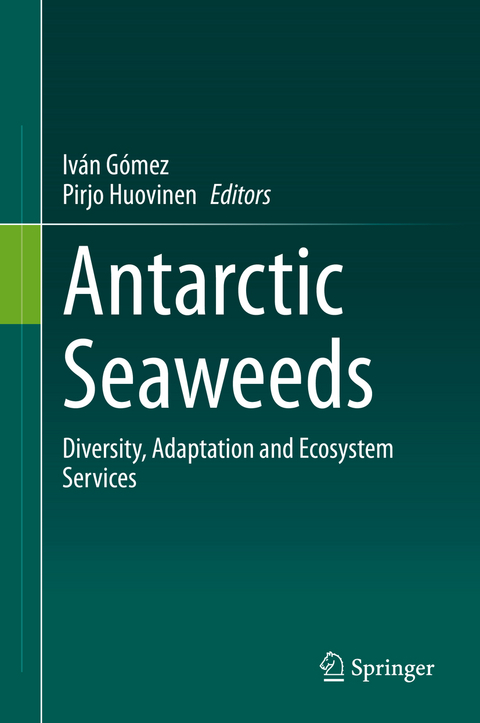
Antarctic Seaweeds
Springer International Publishing (Verlag)
978-3-030-39447-9 (ISBN)
Ivan GomezCurrently a Full Professor at the Instituto de Ciencias Marinas y Limnologicas, Universidad Austral de Chile and Deputy Director of the Fondap Research Center Dynamic of High Latitude Marine Ecosystems (IDEAL). In 1991, Prof. Gomez completed his bachelor and MSci studies at the Universidad Austral de Chile in Valdivia. In 1993 he was awarded a DAAD fellowship to continue his PhD studies at the Alfred Wegener Institute for Polar and Marine Research and the University of Bremen, Germany. He subsequently pursued postdoctoral research at the Universidad de Malaga, Spain and the Alfred Wegener Institute, prior to being appointed at the Universidad Austral de Chile in 2002. Prof. Gomez has considerable experience in the coordination of diverse research projects focused on the ecology, photobiology and physiology of seaweeds from different coastal systems, including cold-temperate and polar regions. He has participated in 11 campaigns in the Antarctic. He recently published the book "Flora Marina Antartica: Patrimonio de Biodiversidad," which condenses the work of many years in a format accessible to a general audience. Pirjo HuovinenShe is currently an Associate Professor at Instituto de Ciencias Marinas y Limnologicas, Universidad Austral de Chile, and an Associate Investigator at the Fondap Research Center Dynamics of High Latitude Marine Ecosystems (IDEAL), Chile. She received her MSc degree in Biology from the University of Joensuu and PhD in Environmental Sciences from the University of Jyvaskyla, Finland. Her research activities have included stays at Department of Environmental Science and Policy and at Bodega Marine Laboratory, University of California-Davis, USA, and at the Departamento de Ecologia, Universidad de Malaga, Spain. Since 2005, she has worked in Chile, first at the research center Centro i-mar, Universidad de los Lagos, Puerto Montt, until her appointment at the Universidad Austral de Chile, Valdivia, in 2010. Her main research interests are related to ecophysiology and photobiology of algae, ecotoxicology, water bio-optics and recently to remote sensing applied to the study of aquatic organisms. Since 2010, she has been involved in several Antarctic research projects and field campaigns.
Antarctic Seaweeds: Biogeography, Adaptation and Ecosystem Services.- Diversity of Antarctic Seaweeds.- Biogeographic Processes Influencing Antarctic and Sub-Antarctic Seaweeds.- Detached Seaweeds as Important Dispersal Agents Across the Southern Ocean.-Biogeography of Antarctic Seaweeds Facing Climate Changes.- Comparative Phylogeography of Antarctic Seaweeds: Genetic Consequences of Historical Climatic Variations.- Underwater Light Environment of Antarctic Seaweeds.- Production and Biomass of Seaweeds in Newly Ice-Free Areas: Implications for Coastal Processes in a Changing Antarctic Environment.- Carbon Balance Under a Changing Light Environment .- Life History Strategies, Photosynthesis and Stress Tolerance in Propagules of Antarctic Seaweeds.- Form and Function in Antarctic Seaweeds: Photobiological Adaptations, Zonation Patterns and Ecosystem Feedbacks.- Successional Processes in Antarctic Benthic Algae.- Seaweed-Herbivore Interactions: Grazing as Biotic Filtering in Intertidal Antarctic Ecosystems.- Diversity and Functioning of Antarctic Seaweed Microbiomes.- Seaweeds in the Antarctic Marine Coastal Food Web.- Trophic Networks and Ecosystem Functioning.- Chemical Mediation of Antarctic Macroalgal-Grazer Interactions.- Brown Algal Phlorotannins: An Overview of their Functional Roles.
| Erscheinungsdatum | 31.12.2019 |
|---|---|
| Zusatzinfo | XIV, 397 p. 68 illus., 63 illus. in color. |
| Verlagsort | Cham |
| Sprache | englisch |
| Maße | 155 x 235 mm |
| Gewicht | 781 g |
| Themenwelt | Naturwissenschaften ► Biologie ► Botanik |
| Naturwissenschaften ► Biologie ► Ökologie / Naturschutz | |
| Naturwissenschaften ► Biologie ► Zoologie | |
| Schlagworte | Algae ecophysiology • Benthic food web • Ecosystem services • genetic diversity • macroalgae • Photosynthetic and primary production • Polar science • Seaweed biological interactions • Seaweed biological interactions • Seaweeds biogeography and dispersion • Stress physiology |
| ISBN-10 | 3-030-39447-6 / 3030394476 |
| ISBN-13 | 978-3-030-39447-9 / 9783030394479 |
| Zustand | Neuware |
| Haben Sie eine Frage zum Produkt? |
aus dem Bereich


